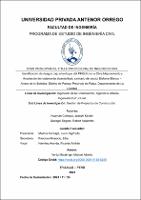Mostrar el registro sencillo del ítem
Identificación de riesgos bajo el enfoque del PMBOK en la Obra Mejoramiento y Ampliación del sistema de alcantarillado sanitario del sector Elefante Blanco – Anexo de la Soledad, Distrito de Parcoy, Provincia de Pataz, Departamento de La Libertad
| dc.contributor.advisor | Vertiz Malabrigo, Manuel Alberto | |
| dc.contributor.author | Huamán Carhuaz, Joseph Keblen | |
| dc.contributor.author | Sabogal Segura, Robert Alejandro | |
| dc.creator | Huamán Carhuaz, Joseph Keblen | |
| dc.date.accessioned | 2024-01-08T20:34:40Z | |
| dc.date.available | 2024-01-08T20:34:40Z | |
| dc.date.issued | 2024 | |
| dc.identifier.uri | https://hdl.handle.net/20.500.12759/16792 | |
| dc.description.abstract | El objetivo principal de este estudio fue desarrollar una matriz de identificación de riesgos en el marco del enfoque del PMBOK para la implementación de la Obra Mejoramiento y Ampliación del sistema de alcantarillado sanitario del sector Elefante Blanco – Anexo de la Soledad, Distrito de Parcoy, Provincia de Pataz, Departamento de La Libertad y desarrollar un plan de gestión basado en los lineamientos propuestos en el PMBOK. iba a ejecutar. Guía 6ª edición. El proceso de gestión de riesgos está determinado por los pasos de identificación de riesgos, análisis de riesgos y planificación del tratamiento de riesgos, y consta de lo siguiente: tipo de riesgo, descripción del riesgo, causas del riesgo, asignación de riesgos, estrategia, medidas de tratamiento de riesgos y nivel de riesgo. Se ha creado una matriz de riesgos completa; esto logra el objetivo general del estudio, los hallazgos del estudio identifican una lista de riesgos y un plan de respuesta para cada uno de los cuales se considerarán durante todo el ciclo del proyecto, optimizando así las posibilidades de éxito del proyecto. La conclusión del análisis cualitativo de riesgos fue que al emplear la guía del PMBOK 6ed., la cual nos brindó las herramientas y estrategias que, junto a criterio personal, se desarrolló esta investigación. Se determinó que el 100% de los riesgos identificados por fenómenos naturales fueron de prioridad moderada. En el análisis cuantitativo de riesgos se pudo apreciar que la probabilidad para cumplir con el presupuesto base es del 49.70%, con una certeza de 95 % por el monto de S/ 417,093.27. Finalmente, la propuesta del plan de respuesta, se determinó en base al análisis cualitativo; se pone mayor énfasis en los riesgos de prioridad moderada y alta prioridad, ya que entre los 2 representan el 89.0% de los riesgos totales | es_PE |
| dc.description.abstract | The main objective of this study was to develop a risk identification matrix within the framework of the PMBOK approach for the implementation of the Improvement and Expansion Work of the sanitary sewage system in the Elefante Blanco sector - Annex de la Soledad, Parcoy District, Province of Pataz, Department of La Libertad and develop a management plan based on the guidelines proposed in the PMBOK. was going to execute. Guide 6th edition. The risk management process is determined by the steps of risk identification, risk analysis and risk treatment planning, and consists of the following: risk type, risk description, risk causes, risk allocation, strategy, risk treatment measures and risk level. A complete risk matrix has been created; This achieves the overall objective of the study, the findings of the study identify a list of risks and a response plan for each of which will be considered throughout the project cycle, thus optimizing the chances of project success. The conclusion of the qualitative risk analysis was that by using the PMBOK 6ed. guide, which provided us with the tools and strategies that, together with personal criteria, this investigation was developed. It was determined that 100% of the risks identified by natural phenomena were of moderate priority. In the quantitative risk analysis, it could be seen that the probability of meeting the base budget is 49.70%, with a certainty of 95% for the amount of S/ 417,093.27. Finally, the response plan proposal was determined based on qualitative analysis; Greater emphasis is placed on moderate priority and high priority risks, since between the two they represent 89.0% of the total risks | es_PE |
| dc.description.uri | Tesis | es_PE |
| dc.format | application/pdf | es_PE |
| dc.language.iso | spa | es_PE |
| dc.publisher | Universidad Privada Antenor Orrego | es_PE |
| dc.relation.ispartofseries | T_CIVIL_2390 | |
| dc.rights | info:eu-repo/semantics/openAccess | es_PE |
| dc.rights.uri | https://creativecommons.org/licenses/by/4.0/ | es_PE |
| dc.source | Universidad Privada Antenor Orrego | es_PE |
| dc.source | Repositorio Institucional - UPAO | es_PE |
| dc.subject | Gestión de riesgos | es_PE |
| dc.subject | identificación, análisis | es_PE |
| dc.subject | planificación | es_PE |
| dc.title | Identificación de riesgos bajo el enfoque del PMBOK en la Obra Mejoramiento y Ampliación del sistema de alcantarillado sanitario del sector Elefante Blanco – Anexo de la Soledad, Distrito de Parcoy, Provincia de Pataz, Departamento de La Libertad | es_PE |
| dc.type | info:eu-repo/semantics/bachelorThesis | es_PE |
| thesis.degree.level | Título Profesional | es_PE |
| thesis.degree.grantor | Universidad Privada Antenor Orrego. Facultad de Ingeniería | es_PE |
| thesis.degree.name | Ingeniero Civil | es_PE |
| thesis.degree.discipline | Ingeniería Civil | es_PE |
| dc.subject.ocde | https://purl.org/pe-repo/ocde/ford#2.01.00 | es_PE |
| renati.advisor.orcid | https://orcid.org/0000-0001-9168-8258 | es_PE |
| renati.author.dni | 46929648 | |
| renati.author.dni | 47635345 | |
| renati.advisor.dni | 18112316 | |
| renati.type | https://purl.org/pe-repo/renati/type#tesis | es_PE |
| renati.level | https://purl.org/pe-repo/renati/level#tituloProfesional | es_PE |
| renati.discipline | 732016 | es_PE |
| renati.juror | Medina Carbajal, Lucio Sigifredo | |
| renati.juror | Panduro Alvarado, Elka | |
| renati.juror | Narváez Aranda, Ricardo Andrés | |
| dc.publisher.country | PE | es_PE |
Ficheros en el ítem
Este ítem aparece en la(s) siguiente(s) colección(es)
-
Ingeniería Civil [1260]




